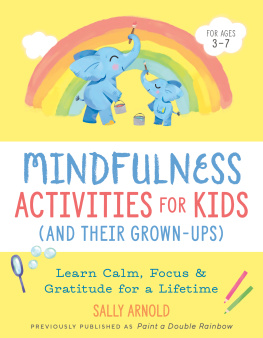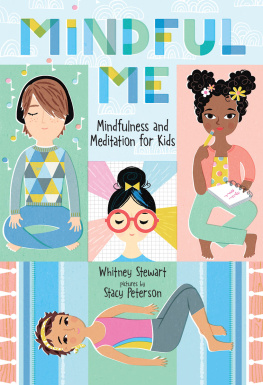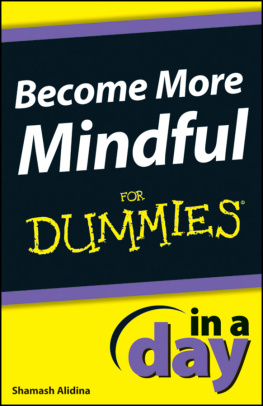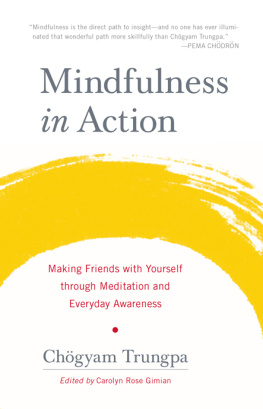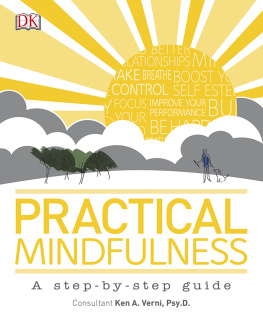Contents
Guide

The author and publisher have provided this e-book to you for your personal use only. You may not make this e-book publicly available in any way. Copyright infringement is against the law. If you believe the copy of this e-book you are reading infringes on the authors copyright, please notify the publisher at: us.macmillanusa.com/piracy.
For Roanne, for Rob, for Arne
Mindfulness needs a redesign.
There has never been as much interest in mindfulness and meditation as there is right now. A growing base of scientific research is providing substantial evidence for its benefits and effects. Leading companies are teaching it to their employees to manage stress. Elite athletes use it to stay calm and perform under pressure. Celebrities are taking it on as a must-have lifestyle accessory, and most important, people just like you are discovering how making mindfulness part of their lives can have a significantly positive impact. Thats the good news.
The bad news is that despite all this, most people who have an interest in mindfulness do not actually go on to do anything about it. There are three main barriers that stop people moving mindfulness from a nice idea to a lived reality: the time problem, the hippy problem and the digital problem. As a maker of mindfulness-related products, these are actually the challenges that get me the most excited since they can all be overcome.
I just dont have time to meditate. This is the time problem. In an over-scheduled world with all our various commitments, finding a quiet ten or twenty minutes to dedicate to ourselves feels like an impossible task. So when we hear that to get the most out of mindfulness we have to do exactly that, of course it feels out of reach. If this is you, please dont worry. Well solve the time problem.
You have to be spiritual or religious to get into meditation and thats just not me . This is the hippy problem. Mindfulness-based meditation does originate from the Buddhist tradition. And even though Buddhism has perhaps the best PR department out of all the major world religions, the spiritual aesthetic and other baggage tied up with mindfulness and meditation is a very real barrier for a lot of people. Thats fine too. We will solve the hippy problem.
I live a very connected life and its just not practical for me to unplug everything. This is the digital problem. Mindfulness and technology are commonly presented as being in opposition to each other. Too often we are told that the only way to be truly present and connected is to turn everything off. But in a world where our work, our lifestyle and our economy are so fundamentally dependent on technology, when it comes to our well-being we simply cannot afford to keep demonizing all things digital. But fear not. We will solve the digital problem as well.
This is a next-generation mindfulness book. It is for the millions of people who struggle to find space in the busyness of it all. It is for the millions of people all around the world who would love more awareness, more calm and more kindness in their lives. It is for the millions of people who have never felt that mindfulness or meditation was for them. This book is for you.
Notice what it feels like to read these opening paragraphs. Notice if any particularly strong thoughts or reactions have come up. Maybe theres some excitement. Maybe theres some doubt.
Notice if there are any clear physical sensations present in the body. Maybe you can notice what your breath is like right now. Or what the movements that make up blinking actually feel like. Or even the simple sensations you can feel from holding this book in your hands. This is going to be fun.
* * *
If you are the kind of person who can easily find time in your day for formal sitting meditation practice, dont have a problem with bald people in robes telling you what to do, and can give up using your digital devices, then congratulations. There are already plenty of good mindfulness and meditation approaches out there that will work for you. But the chances are that youre not. The three problems I mentioned previously are often thought of as just being facts of meditation life. Thats what mindfulness is like, deal with it. This is just plain wrong and the reason why we need a mindfulness that is better designed for the realities of our modern lives.
The approach outlined in this book solves the time problem by reframing meditation primarily as a mobile activitysomething we can do everywhere, not just when sitting on a cushion in a quiet space. It solves the hippy problem by understanding that while it certainly has religious roots, mindfulness has evolved and is now being used for reasons that are entirely new. It solves the digital problem by embracing the importance of technology in our lives and learning how to actually use our devices as the basis of our well-being, not its nemesis.
The alternative is that we simply carry on thinking about mindfulness in the same ways that we do today. If we do, then mindfulness will continue to be a minority sport. It will be a luxury, unavailable to the vast majority of people whose lifestyles and values do not fit with the conventional presentation. Given the growing evidence of how mindfulness practice can lead to so many different positive outcomes, that would be a real shame. Here is this awesome thing but, sorry, its not for you .
As well as being a shame, it would be ignoring the fact that the story of mindfulness is one of innovation and change. Later on well look more closely at how mindfulness has evolved over time and also where it might go next. However, before starting out in our adventures into mindfulness, there is one big idea that it is worth you knowing. Mindfulness is a flexible tradition and it has a long history of reimagining itself every time it meets a new culture. The ways in which mindfulness is changing today are therefore just a natural next chapter as it adapts in response to things it has only recently met, such as neuroscience, psychology and digital technology.
Referring to the history of mindfulness and how it changes doesnt need to feel abstract. What we are actually talking about are individuals like you and me taking what has gone before and working out how best to apply that to the realities of our lives as they are right now. My own big breakthrough was when I discovered how to meditate in a time-poor world. It not only changed my understanding of mindfulness, it went on to change my whole life.
Finding the future of mindfulness on the way to work
I got into meditation during my last few months at university and upon graduation I moved back to London to begin work with a large technology consulting company. It was an exciting time all round. I was enjoying the energetic corporate lifestyle, making decent headway into my student debt, and my interest in mindfulness and meditation was really starting to take off. I had begun to look for classes and groups near me, and I was even considering going on a weekend retreat.
The problem was that I didnt have time to fit it all in. Id had no such problems in my student life, where I could happily find a spare half hour. But it was entirely different now that I had been fast-tracked into the long-work-hours corporate culture. Even when I did find time for dedicated sitting meditation, I was often so tired that the quality of my attention and energy was such that I could not do it justice. So I was surprised when I found the solution to my problem on the Northern Line one Monday morning.


